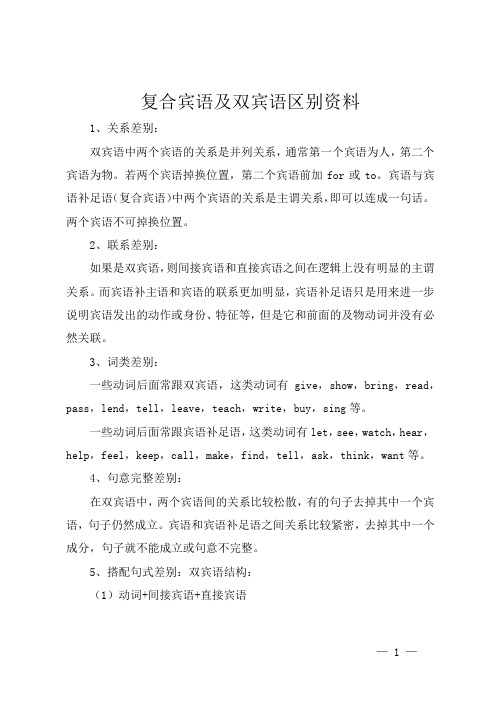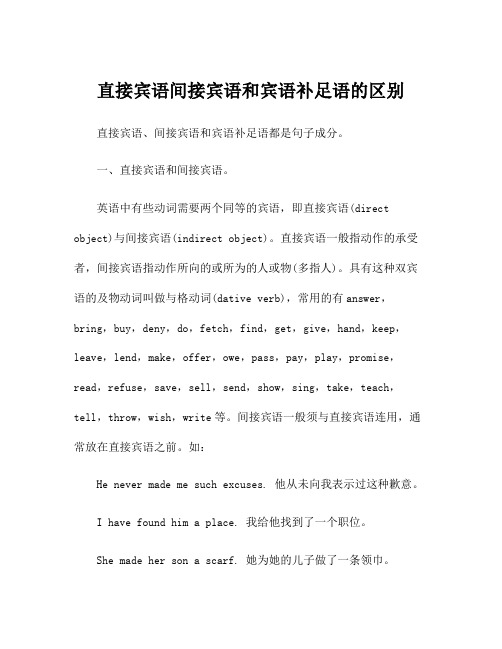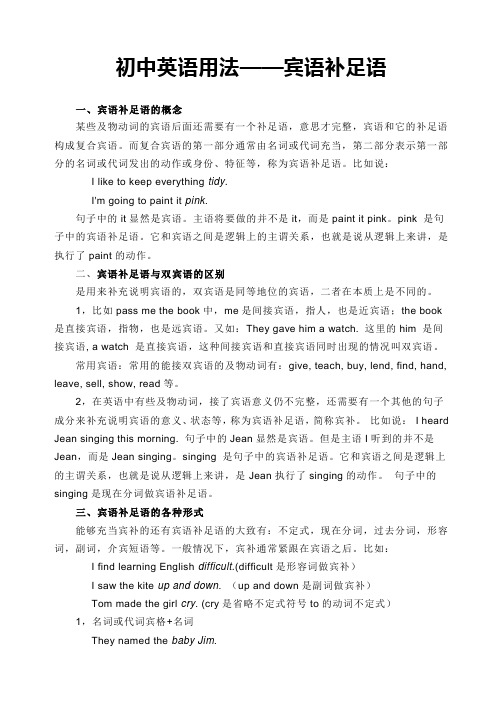英语中的双宾语和宾语补足语的区别
双宾语与宾补的区别

• We make Lijian our monitor. 〔名词〕 • 我们选李建为班长。 • He didn’t let me go.〔动词原形〕 • 他不让我走. • We must keep the classroom clean。〔形
容词〕
• 我们必须保持教室清洁. • English teacher asks me to keep quiet.〔动
=He gave a book to me
• 4. The boy wanted to ride his bicycle in the 动词+直接宾语+for+间接宾语
=She made coffer for us. He didn’t let me go.
street, but his mother told him ___. =He gave a book to me
词后加to〕 • 英语教师要求我们保持安静。
单项选择
• 1. Though he had often made his little
sister ____, today he was made ____ by Can you see________?
My parents bought me a computer.
what is he reading
his little sister. I found the door _____ when I got home.
not making
D.
双宾语与宾语补足语的区别
• cry; to cry B. crying; crying 其中间接宾语是指人的,直接宾语是指物的
do not to 双宾语与宾语补足语的区别
双宾语和宾补

句子成分分析(二)双宾语和宾语补足语Please show me your new book.She bought me some tomatoes.He gave Tom a piece of paper.The old man told us a story yesterday.They teach us Chinese and we teach them English.直接宾语:通常指动作的承受者,是动作所涉及到的人或物。
但在双宾语结构中一般指物。
He does't like cold weather.The news surprised us.She bought me some tomatoes.He gave Tom a piece of paper.间接宾语:一般指动作的对象或受益者,也就是说间接宾语表示对谁或为谁做的。
在双宾语结构中一般指人。
We made Tom monitor.We will make our country more beautiful. You should keep your dog in.I found him in Room 201.宾语补足语:宾语和宾语补足语之间关系比较紧密,去掉其中一个成分,句子就不能成立或句意不完整。
宾语和宾补之间有“主系表”关系或“主谓”关系。
We made Tom monitor.(Tom is monitor.)We will make our country more beautiful.(Our country will be more beautiful)You should keep your dog in.(Your dog should be in.)I found him in Room 201.(He was in Room 201.)双宾语和宾补的区别:1.双宾语可以改写成to sb. 或for sb. 的形式2.从动词上区分后面常跟双宾语的动词有give,show,bring,read,pass,lend,tell,leave,teach,write,buy,sing等后面常跟复合宾语的动词有let,see,watch,hear,help,feel,keep,call,make,find,tell,ask,think,want等。
复合宾语及双宾语区别资料

复合宾语及双宾语区别资料1、关系差别:双宾语中两个宾语的关系是并列关系,通常第一个宾语为人,第二个宾语为物。
若两个宾语掉换位置,第二个宾语前加for或to。
宾语与宾语补足语(复合宾语)中两个宾语的关系是主谓关系,即可以连成一句话。
两个宾语不可掉换位置。
2、联系差别:如果是双宾语,则间接宾语和直接宾语之间在逻辑上没有明显的主谓关系。
而宾语补主语和宾语的联系更加明显,宾语补足语只是用来进一步说明宾语发出的动作或身份、特征等,但是它和前面的及物动词并没有必然关联。
3、词类差别:一些动词后面常跟双宾语,这类动词有give,show,bring,read,pass,lend,tell,leave,teach,write,buy,sing等。
一些动词后面常跟宾语补足语,这类动词有let,see,watch,hear,help,feel,keep,call,make,find,tell,ask,think,want等。
4、句意完整差别:在双宾语中,两个宾语间的关系比较松散,有的句子去掉其中一个宾语,句子仍然成立。
宾语和宾语补足语之间关系比较紧密,去掉其中一个成分,句子就不能成立或句意不完整。
5、搭配句式差别:双宾语结构:(1)动词+间接宾语+直接宾语— 1 —(2)动词+直接宾语+for+间接宾语(3)动词+直接宾语+to+间接宾语其中间接宾语是指人的,直接宾语是指物的宾语补足语结构:(1)动词+人(宾语)+动词原形(2)动词+宾语+形容词(3)动词+宾语+带to的不定式(4)动词+宾语+省to的不定式(5)动词+宾语+名词短语— 2 —。
直接宾语间接宾语和宾语补足语的区别

直接宾语间接宾语和宾语补足语的区别直接宾语、间接宾语和宾语补足语都是句子成分。
一、直接宾语和间接宾语。
英语中有些动词需要两个同等的宾语,即直接宾语(direct object)与间接宾语(indirect object)。
直接宾语一般指动作的承受者,间接宾语指动作所向的或所为的人或物(多指人)。
具有这种双宾语的及物动词叫做与格动词(dative verb),常用的有answer,bring,buy,deny,do,fetch,find,get,give,hand,keep,leave,lend,make,offer,owe,pass,pay,play,promise,read,refuse,save,sell,send,show,sing,take,teach,tell,throw,wish,write等。
间接宾语一般须与直接宾语连用,通常放在直接宾语之前。
如:He never made me such excuses. 他从未向我表示过这种歉意。
I have found him a place. 我给他找到了一个职位。
She made her son a scarf. 她为她的儿子做了一条领巾。
由于种种原因,间接宾语亦可置于直接宾语之后,但其前一般须用介词to或for。
如:I gave my address to him. 我把我的地址给了他。
(强调间接宾语him)He threw the ball to me, not to Tom. 他将球扔给了我,没有扔给汤姆。
(强调me和Tom,并使二者形成对照)I have found a place for Bob, who is my brother. 我给鲍勃找到了一个职位,他是我的兄弟。
(间接宾语Bob后有修饰语) 如直接宾语都是代词,间接宾语亦应放在直接宾语之后。
如:Give it to me. 把它给我。
Why didn’t you show it to him? 你为什么没有将它给他看?如果直接宾语是一从句,间接宾语亦必须放在直接宾语之前。
初中英语语法:宾语补足语

初中英语语法:宾语补足语收集整理:王俊尧一、宾语补足语的概念某些及物动词的宾语后面还需要有一个补足语,意思才完整,宾语和它的补足语构成复合宾语。
而复合宾语的第一部分通常由名词或代词充当,第二部分表示第一部分的名词或代词发出的动作或身份、特征等,称为宾语补足语。
比如说:Iliketokeepeverything tidy.I'mgoingtopaintit pink.显然是宾语。
主语将要做的并不是it,而是paintitpink 。
pink 是句句子中的it子中的宾语补足语。
它和宾语之间是逻辑上的主谓关系,也就是说从逻辑上来讲,是执行了paint的动作。
二、宾语补足语与双宾语的区别宾语补足语是用来补充说明宾语的,双宾语是同等地位的宾语,二者在本质上是不同的。
1,比如passmethebook 中,me 是间接宾语,指人,也是近宾语;thebook 是直接宾语,指物,也是远宾语。
又如:Theygavehimawatch. 这里的him 是间接宾语,awatch 是直接宾语,这种间接宾语和直接宾语同时出现的情况叫双宾语。
常用宾语:常用的能接双宾语的及物动词有:give,teach,buy,lend,find,hand, leave,sell,show,read 等。
2,在英语中有些及物动词,接了宾语意义仍不完整,还需要有一个其他的句子成分来补充说明宾语的意义、状态等,称为宾语补足语,简称宾补。
比如说:Iheard Jeansingingthismorning. 句子中的Jean 显然是宾语。
但是主语I听到的并不是Jean ,而是Jeansinging 。
singing 是句子中的宾语补足语。
它和宾语之间是逻辑上的主谓关系,也就是说从逻辑上来讲,是Jean 执行了singing 的动作。
句子中的singing是现在分词做宾语补足语。
三、宾语补足语的各种形式能够充当宾补的还有宾语补足语的大致有:不定式,现在分词,过去分词,形容词,副词,介宾短语等。
(完整)初中英语语法:宾语补足语

初中英语用法——宾语补足语一、宾语补足语的概念某些及物动词的宾语后面还需要有一个补足语,意思才完整,宾语和它的补足语构成复合宾语。
而复合宾语的第一部分通常由名词或代词充当,第二部分表示第一部分的名词或代词发出的动作或身份、特征等,称为宾语补足语。
比如说:I like to keep everything tidy.I'm going to paint it pink.句子中的it显然是宾语。
主语将要做的并不是it,而是paint it pink。
pink 是句子中的宾语补足语。
它和宾语之间是逻辑上的主谓关系,也就是说从逻辑上来讲,是执行了paint的动作。
二、宾语补足语与双宾语的区别是用来补充说明宾语的,双宾语是同等地位的宾语,二者在本质上是不同的。
1,比如pass me the book中,me是间接宾语,指人,也是近宾语;the book 是直接宾语,指物,也是远宾语。
又如:They gave him a watch. 这里的him 是间接宾语, a watch 是直接宾语,这种间接宾语和直接宾语同时出现的情况叫双宾语。
常用宾语:常用的能接双宾语的及物动词有:give, teach, buy, lend, find, hand, leave, sell, show, read等。
2,在英语中有些及物动词,接了宾语意义仍不完整,还需要有一个其他的句子成分来补充说明宾语的意义、状态等,称为宾语补足语,简称宾补。
比如说:I heard Jean singing this morning. 句子中的Jean显然是宾语。
但是主语I听到的并不是Jean,而是Jean singing。
singing 是句子中的宾语补足语。
它和宾语之间是逻辑上的主谓关系,也就是说从逻辑上来讲,是Jean执行了singing的动作。
句子中的singing是现在分词做宾语补足语。
三、宾语补足语的各种形式能够充当宾补的还有宾语补足语的大致有:不定式,现在分词,过去分词,形容词,副词,介宾短语等。
宾语补足语讲解(整理)
初中英语语法:宾语补足语一、宾语补足语的概念某些及物动词的宾语后面还需要有一个补足语,意思才完整,宾语和它的补足语构成复合宾语。
而复合宾语的第一部分通常由名词或代词充当,第二部分表示第一部分的名词或代词发出的动作或身份、特征等,称为宾语补足语。
句子结构是:主+谓+宾+宾补I'm going to paint it pink.句子中的it显然是宾语。
主语将要做的并不是it,而是paint it pink。
pink 是句子中的宾语补足语。
它和宾语之间是逻辑上的主谓关系,也就是说从逻辑上来讲,是执行了paint的动作。
二、宾语补足语与双宾语的区别宾语补足语是用来补充说明宾语的,双宾语是同等地位的宾语,二者在本质上是不同的。
1、比如pass me the book中,me是间接宾语,指人,也是近宾语;the book是直接宾语,指物,也是远宾语。
又如:They gave him a watch. 这里的him 是间接宾语, a watch 是直接宾语,这种间接宾语和直接宾语同时出现的情况叫双宾语。
常用宾语:常用的能接双宾语的及物动词有give, teach, buy, lend, find, hand, leave,sell, show, read等。
2、在英语中有些及物动词,接了宾语意义仍不完整,还需要有一个其他的句子成分来补充说明宾语的意义、状态等,称为宾语补足语,简称宾补。
比如说: I heard Jean singing this morning. 句子中的Jean显然是宾语。
但是主语I听到的并不是Jean,而是Jean singing。
singing 是句子中的宾语补足语。
它和宾语之间是逻辑上的主谓关系,也就是说从逻辑上来讲,是Jean执行了singing的动作。
句子中的singing是现在分词做宾语补足语。
三、宾语补足语的各种形式能够充当宾补的还有宾语补足语的大致有:不定式,现在分词,过去分词,形容词,副词,介宾短语等。
英语中宾语补足语和双宾语的区别
宾语补足语或复合宾语和双宾语在句中都由两部分组成,双宾语由直接宾语 + 间接宾语构成,直接宾语和间接宾语都是名词性质的成分;宾语补足语跟在直接宾语后面,与其构成复合宾语,有多种语法形态,那么在句中要如何区分它们呢?一、从充当成分的词性来区分1、能充当直接宾语或是间接宾语的一般是名词,名词短语或是代词,例如:A、动词 + 间接宾语 + 直接宾语I gave him some money yesterday.我昨天给了他一些钱。
I will buy her a book tomorrow.我明天给她买本书。
The teacher gave her a warning.老师给了她一个警告。
B、动词 + 直接宾语 + for + 间接宾语They baked bread for me.他们给我烤面包。
I found a pen for you.我给你找了支钢笔。
I poured a glass of water for you.我给你倒了一杯水。
C、动词 + 直接宾语 + to + 间接宾语They awarded a gold medal to top 10 schools.他们给十大名校颁发了一枚金牌。
They offered a management job to me.他们给我提供了一份管理工作。
I sent some money to you.我给你寄了一些钱。
2、能充当宾语补足语的通常有形容词及形容词短语,带 to 的不定式,不带to 的不定式,名词及名词短语,现在分词或过去分词,例如:A、动词 + 直接宾语 + 形容词(短语)We all consider her unworthy.我们都认为她不值的。
The evidence proved the accused innocent.证据证明被告无罪。
My husband and I painted our living room lime green. 我和丈夫把客厅漆成了青柠色。
宾语和宾语补足语
宾语和宾语补足语1. 双宾语直接宾语和间接宾语双宾语就是有些动词后面跟直接宾语和间接宾语. 直接宾语指的是动词所涉及的物,间接宾语是指受益于动词所表示的行为的人.We owe the university 400 dollars for Jenny's tuition.They sent us a bill for the new semester .(在英语中,有些动词接了一个宾语后句子意思仍不完整,还需要再加上一个词或短语放在宾语之后来补充说明其身份、特征、状态或所做的动作,这种“宾语+宾语补足语”结构称为复合宾语)在双宾语中,两个宾语间的关系比较松散,有的句子去掉其中一个宾语,句子仍然成立。
双宾语一般表示“为谁(for sb.)或给谁(to sb.)……”,即“及物动词+间接宾语+直接宾语”的结构可以改写为“及物动词+直接宾语+for sb.或to sb.”的结构。
例如:He brings me cookies every day.She made me a beautiful dress.常跟双宾语的动词有:to: advance, allot, allow, award, bring, cause, deal, deliver, deny, do, feed, fetch, forward, give, grant, hand, leave, lend, loan, mail, offer, owe, pass, pay, play, post, proffer, promise, quote, read, recommend, refuse, render, rent, replay, restore, return, sell, send, serve, show, sing, take, teach, tell, throw, tell, toss, write for: boil, book, bring, build, buy, call, cash, choose, cook, cut, design, do, fetch, fill, find, fix, gather, get, grow, guarantee, keep, leave, make, mix, order, paint, pick, play, pour, prepare, pull, reach, reserve, save, secure, set, sing, spare, spread, take, win, write, yield(to还是for,这里没有固定的规则,主要取决于不同动词的性质,以及句子的意思。
基础知识 双宾语和宾语补足语 讲义 高三英语上学期一轮复习专项
基础知识:双宾语和宾语补足语双宾语:就是有两个宾语,一个是直接宾语(direct object),一个是间接宾语(indirect object)。
直接宾语的例子:Sasha paints landscapes.The kindergarteners prefer shortstories over poetry.Europe welcomed millions of tourists last year.我们可以看到红色的宾语,都是谓语动词这个“动作”的承受者。
1,画风景画2,更喜欢短故事3,欢迎游客所以直接宾语就是谓语动词的承受者。
间接宾语的例子:Martin read Maria a book.Stan built Julie ahouse.John threw Steve a ball.根据直接宾语的例子,我们知道直接宾语是谓语动词的承受者,那么我们就能看出名词book,house,ball都是直接宾语。
1,Martin读书给Maria2,Stan盖房子给Julie3,John扔球给Steve间接宾语是Maria,Julie,Steve,是直接宾语的对象,to whom/what或者for whom/what如:Martin read a book to Maria.He made me a cake.=He made a cake for me.这样就能看出直接宾语是紧跟在谓语后面的。
宾语补足语(object complement)宾补是指跟在直接宾语后面,对直接宾语进行说明,补充说明宾语的状态。
宾语是名词或者代词,但是宾补可以是形容词、副词、动词、名词、不定式、分词、介宾短语等。
例:Chocolate makes Tanya happy.She just called me a singer.I found Joyce working.我们可以发现宾语后面如果没有词的话,那么这句话就不完整1,巧克力让Tanya,怎么了,没有说明2,她刚刚叫我,叫我干什么,也没有说明3,我发现Joyce,倒是可以,但是明显没有把说话人的意图表示清楚所以宾补的作用就是要补充、说明1,Chocolate makes Tanya happy. Tanya和happy之间有逻辑关系,即:Tanya is happy.2,Shecalled me a singer. me和singer的逻辑关系是I am a singer.3,I found Joyce working.Joyce和working的逻辑关系是Joyce is working.例:1.The panel judges named her this year’s winner for best performance. (名词短语)2.They caught little Jessica red-handed reaching into the cookie jar at midnight.(形容词短语)3.Both critics and moviegoers declared the film a flop and thewriting a disaster. (名词)4.“They called the movie what?” said the director.(代词)5.The letter you wrote made me joyful. (形容词)6.He worked on the model until he felt he had made it perfect.7.After reviewing the details of the case, the court pronounced the boy not guilty.as和as being后面跟补语动词+宾语+as (being) +补语asI think of the government as useless.She declared the dish as delicious as a five-star meal.The judges regard him as worthy of the prize.He described his wife as loyal, loving and faithful.as beingHe sees the car as being a classic beauty.They consider him as being a very smart person.She sees him as being emotionally draining.The teacher regards him as being disruptive in class.宾语补足语和主语补足语宾补:是对宾语的补充主补:是对主语的补充宾补与宾语在逻辑上有主谓关系如:You should keep the window open.open是对宾语window的补充the window is open是逻辑上的主谓关系主补与主语也有逻辑上的主谓关系如:The window should be kept open.She was elected chairman of Students’ Union.把这句写成主动语态:We elected her chairman of Students’ Union从上面的例句看出,主补通常在被动语态中,宾语变主语,宾补变主补。
- 1、下载文档前请自行甄别文档内容的完整性,平台不提供额外的编辑、内容补充、找答案等附加服务。
- 2、"仅部分预览"的文档,不可在线预览部分如存在完整性等问题,可反馈申请退款(可完整预览的文档不适用该条件!)。
- 3、如文档侵犯您的权益,请联系客服反馈,我们会尽快为您处理(人工客服工作时间:9:00-18:30)。
详解双宾语和宾语补足语的区别:以make, give举例说明
双宾语结构:1. 动词+间接宾语+直接宾语
2. 动词+直接宾语+for+间接宾语
3. 动词+直接宾语+to+间接宾语
其中间接宾语是指人的,直接宾语是指物的
宾语补足语结构:1.动词+人(宾语)+动词原形
2.动词+宾语+形容词
3.动词+宾语+带to的不定式
4.动词+宾语+省to的不定式
5.动词+宾语+名词短语
其中红色部分作为句子的宾补成分, 特别强调的是宾
语补足语不可以和宾语换位置。
一、举例说明双宾语:
1. She made us coffee.
其中us 为句子的间接宾语coffer为句子的直接宾语。
本句子可改为同义句:
She made coffer for us.
2. He gave me a book.
其中me 为句子的间接宾语a book为句子的直接宾语。
本句子可改为同义句:
He gave a book to me
二、举例说明宾语补足语:
We make Lijian our monitor.
其中红色为宾补成分
这个句子最容易让人弄错,以为是双宾语,其实是our monitor作为句子的宾语补足语,这个句子是不可以改写成:
We make our monitor for Lijian. (×)
He asked me some questions.
这个句子容易让人误认为是宾语补足语结构,实际是双宾语结构,只不过这个句子中的动词的间接宾语不能+to或+for,这类动词还有cost, refuse, promise
The book cost me five yuan.
三、动词+直接宾语+for+间接宾语,这种结构中能用for改为同义句的动词有:buy, play, make, find,keep,choose,cut,cook,wash等
Please cut Tom the cake.= Please cut the cake for Tom.
My father often washes me the clothes.=My father often washes the clothes for me.
My father often cooks me lunch.=My father often cooks lunch for me. 四、动词+直接宾语+to+间接宾语,这种结构中能用to改为同义句的动词有:七给give, hand, pass, lend, send, show, write,一带bring,还有pay, teach, tell, wish, return, sell, read,等
I returned him the storybook= I returned the storybook to him.
He showed all his friends his pictures.= He showed his pictures to all his friends.
He sent me a book.= He sent a book to me。
